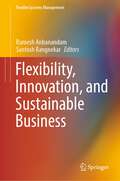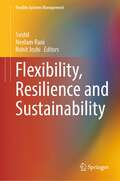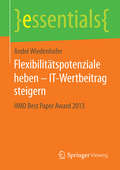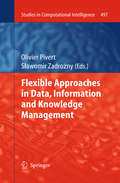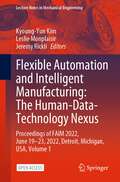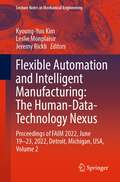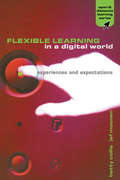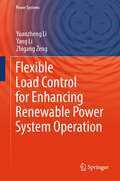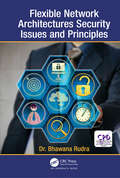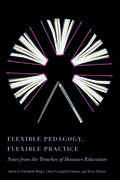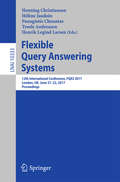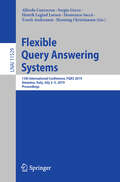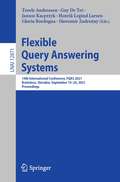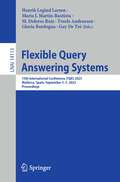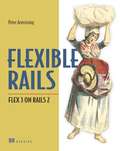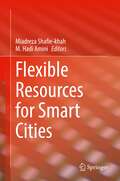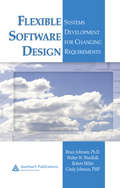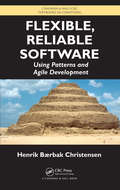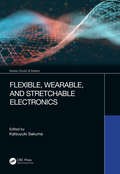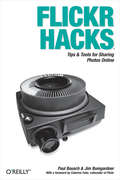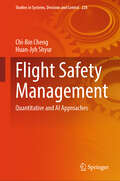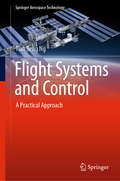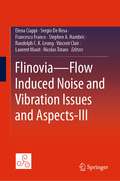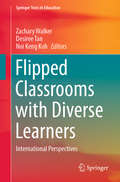- Table View
- List View
Flexibility, Innovation, and Sustainable Business (Flexible Systems Management)
by Ramesh Anbanandam Santosh RangnekarThis book contains practical experiences, knowledge, and insights in the evolution, formulation, and implementation of strategies and models for flexibility, innovation, and sustainable business. The book discussed the increasing significance of a flexible approach by businesses as much as possible in every area of their work—from employment policies to supply chain management (SCM). It further links this flexible approach to a sustainability strategy, which is necessary to be competitive today and in the future. This business approach is necessary to create long-term value by considering how a given organization operates in the ecological, social, and economic environment. This is linked to the next theme of the book—innovation—which is fundamental for a business to improve its processes, develop new and improved products and services for the market, increase its efficiency, and, most importantly, get better profitability. The book also delves into another buzz word in business—analytics. Companies have widely embraced the use of analytics to streamline operations and improve processes. The book explores all these critical emerging areas through the chapters in its five sections and is invaluable for management students and researchers, practicing business managers, consultants, professional institutions, and government and corporate organizations.
Flexibility, Resilience and Sustainability (Flexible Systems Management)
by Sushil Neelam Rani Rohit JoshiThis book discusses initiatives intended to promote strategic flexibility, resilience, sustainability, and information system flexibility and analytics, through AI, HR analytics, employee attrition using perspectives from machine learning, agile competencies, agile organization, digital recruitment, e-governance, cyber security controls, and cyber security risk management. It explores areas such as banking system, medical tourism, pharmaceutical industry, defense sector, online shopping, to name some. It brings different perspectives on how to improve the resilience of human resources in organizations through employee engagement, exploration, experimentation, and so on, to create sustainable organizations. There is also some focus on innovation and environmental sustainability concerns, co-worker support, exploring the linkages, and in one case, culture essentials for Industry 5.0. Divided into three parts, covering a range of topics, contexts, and methods used to understand the relevant issues in flexibility, resilience, and sustainability, thes book is a useful addition to the literature on the topic as well as a practical resource for practitioners. It will be a useful resource for a variety of audiences such as management students and researchers, practicing business managers, consultants, and professional institutions.
Flexibilitätspotenziale heben - IT-Wertbeitrag steigern: HMD Best Paper Award 2013 (essentials)
by André WiedenhoferIn den vergangenen Jahren nahm die Veränderungsgeschwindigkeit in den Unternehmen stetig zu. Die wachsende Globalisierung, die Auswirkungen der Krise und die rasch wandelnden Technologien haben bewährte Geschäftsmodelle grundlegend in Frage gestellt. Die ständige Anpassung wird ,,business as usual". Dadurch bedingt ändern sich die Anforderungen an die betriebliche Informationstechnologie (IT). Um einen wesentlichen Wertbeitrag zu generieren, muss die IT der marktinduzierten Unsicherheit mit einem angemessenen Grad an Flexibilität begegnen. In Anlehnung an die ressourcenorientierte Theorie stellt André Wiedenhofer die IT als wesentliche Kernkompetenz dar. Da Unsicherheit in der Literatur bisher kaum Beachtung gefunden hat und Flexibilitätspotenziale scheinbar noch nicht ausgeschöpft sind, soll der Beitrag Handlungsempfehlungen geben, wie die IT langfristig ihren Wertbeitrag organisatorisch verbessern kann.
Flexible Approaches in Data, Information and Knowledge Management
by Olivier Pivert Sławomir ZadrożnyThis volume showcases contributions from internationally-known researchers in the field of information management. Most of the approaches presented here make use of fuzzy logic, introduced by L. A. Zadeh almost 50 years ago, which constitute a powerful tool to model and handle gradual concepts. What all of these contributions have in common is placing the user at the center of the information system, be it for helping him/her to query a data set, to handle imperfect information, or to discover useful knowledge from a massive collection of data. Researchers working in data and knowledge management will greatly benefit from this collection of up-to-date studies. This may be also an invaluable source of information for postgraduate students interested in advanced information management techniques.
Flexible Automation and Intelligent Manufacturing: Proceedings of FAIM 2022, June 19–23, 2022, Detroit, Michigan, USA (Lecture Notes in Mechanical Engineering)
by Kyoung-Yun Kim Leslie Monplaisir Jeremy RickliThis is an open access book. It gathers the first volume of the proceedings of the 31st edition of the International Conference on Flexible Automation and Intelligent Manufacturing, FAIM 2022, held on June 19 – 23, 2022, in Detroit, Michigan, USA. Covering four thematic areas including Manufacturing Processes, Machine Tools, Manufacturing Systems, and Enabling Technologies, it reports on advanced manufacturing processes, and innovative materials for 3D printing, applications of machine learning, artificial intelligence and mixed reality in various production sectors, as well as important issues in human-robot collaboration, including methods for improving safety. Contributions also cover strategies to improve quality control, supply chain management and training in the manufacturing industry, and methods supporting circular supply chain and sustainable manufacturing. All in all, this book provides academicians, engineers and professionals with extensive information on both scientific and industrial advances in the converging fields of manufacturing, production, and automation.
Flexible Automation and Intelligent Manufacturing: Proceedings of FAIM 2022, June 19–23, 2022, Detroit, Michigan, USA, Volume 2 (Lecture Notes in Mechanical Engineering)
by Kyoung-Yun Kim Leslie Monplaisir Jeremy RickliThis book gathers the second volume of the proceedings of the 31st edition of the International Conference on Flexible Automation and Intelligent Manufacturing, FAIM 2022, held on June 19 – 23, 2022, in Detroit, Michigan, USA. Covering four thematic areas including Manufacturing Processes, Machine Tools, Manufacturing Systems, and Enabling Technologies, it highlights advances in micro- and nanoscales processes, additive manufacturing, artificial intelligence and robotic applications, human-robot collaboration, as well as quality control, supply chain, industrial monitoring and management strategies. It also discusses important issues related to sustainability, waste management and remanufacturing. All in all, this book provides academicians, engineers and professionals with extensive information on both scientific and industrial advances in the converging fields of manufacturing, production, and automation.
Flexible Learning in a Digital World: Experiences and Expectations (Open and Flexible Learning Series)
by Collis, Betty Moonen, JefBetty Collis and Jef Moonen present a series of proven and practical guidelines, based on their balanced experience of using technology in education. Together, these give readers an overview of how technological applications in education can be developed and harnessed.
Flexible Load Control for Enhancing Renewable Power System Operation (Power Systems)
by Yang Li Zhigang Zeng Yuanzheng LiThis book addresses the pressing challenges faced by renewable power system operation (RPSO) due to the increasing penetration of renewable energy and flexible load. These challenges can be divided into two categories. Firstly, the inherent uncertainties associated with renewable energy sources pose significant difficulties in RPSO. Secondly, the presence of various types of flexible load, along with their complex constraint relationships, adds to the operational complexities. Recognizing the growing emphasis on the economic and low-carbon aspects of RPSO, this book focuses on the key issues of flexible load control. It mainly consists of following categories: (1) The control of data centers, a booming flexible load, to enhance RPSO through renewable energy integration and advanced robust multi-objective optimization. (2) The introduction of flexible industrial load control, employing effective demand-supply cooperative responding strategies for RPSO. (3) The exploration of electricvehicle flexible charging load control and centralized electric vehicle charging system control in the context of RPSO. The book also covers the emerging field of flexible integrated load control for renewable energy-based comprehensive energy system operation. Aimed at researchers, engineers, and graduate students in electrical engineering and computer science, this book provides a valuable resource for understanding and implementing flexible load control in the context of RPSO.
Flexible Network Architectures Security: Principles and Issues
by Bhawana RudraThe future of Internet security doesn’t lie in doing more of the same. It requires not only a new architecture, but the means of securing that architecture. Two trends have come together to make the topic of this book of vital interest. First, the explosive growth of the Internet connections for the exchange of information via networks increased the dependence of both organizations and individuals on the systems stored and communicated. This, in turn, has increased the awareness for the need to protect the data and add security as chief ingredient in the newly emerged architectures. Second, the disciplines of cryptography and network security have matured and are leading to the development of new techniques and protocols to enforce the network security in Future Internet. This book examines the new security architectures from organizations such as FIArch, GENI, and IETF and how they’ll contribute to a more secure Internet.
Flexible Pedagogy, Flexible Practice: Notes from the Trenches of Distance Education
by Elizabeth Burge Chère Campbell Gibson Terry GibsonFlexibility has become a watchword in modern education, but its implementation is by no means a straightforward matter. Flexible Pedagogy, Flexible Practice sheds light on the often taken-for-granted assumptions that inform daily practice and examines the institutional dynamics that help and hinder efforts toward flexibility. The collection in international in scope, drawing on the experience of specialists in distance education from North America, the United Kingdom, Australia and New Zealand, South Africa, Singapore, and Japan. Contributors to the volume were asked to reflect candidly and critically on a series of questions, including: What precisely is flexible learning? Who or what is driving the flexibility agenda, and for whose benefit? And who or what is resisting it? What challenges must be overcome in order to achieve flexibility, and what are some of the compromises it can entail?
Flexible Query Answering Systems
by Henning Christiansen Henrik Legind Larsen Hélène Jaudoin Panagiotis Chountas Troels AndreasenThisvolumeconstitutestheproceedingsoftheFifthInternationalConferenceon Flexible Query Answering Systems, FQAS 2002, held in Copenhagen, Denmark on October 27-29, 2002. FQAS is the premier conference for researchers and practitioners concerned with the vital task of providing easy, ?exible, and intuitive access to information for every type of need. This multidisciplinary conference draws on several re- arch areas, including databases, information retrieval, knowledge representation, soft computing, multimedia, and human-computer interaction. Previous FQAS events were held in 1994, 1996, 1998, and 2000. The overall theme of the FQAS conferences is innovative query systems - medatprovidingeasy,?exible,andintuitiveaccesstoinformation. Suchsystems are intended to facilitate retrieval from information repositories such as data- ses,libraries,andtheWorld-WideWeb. Theserepositoriesaretypicallyequipped with standard query systems which are often inadequate, and the focus of FQAS is the development of query systems that are more expressive, informative, c- perative, and productive. These proceedings contain 29 original papers that relate to the topic of users posing queries and systems producing answers. The papers cover the ?elds: - tabase Management, Information Retrieval, Domain Modeling, Knowledge - presentation and Ontologies, Knowledge Discovery and Data Mining, Arti?cial Intelligence, Classical and Non-classical Logics, Computational Linguistics and Natural Language Processing, Multimedia Information Systems, and Human- Computer Interaction. We wish to thank the contributors for their excellent papers and the referees, publisher, and sponsors for their e?ort. Special thanks also to the invited sp- kers, members of the Advisory Board, and members of the Program Committee. They made the success of FQAS 2002 possible.
Flexible Query Answering Systems: 13th International Conference, FQAS 2019, Amantea, Italy, July 2–5, 2019, Proceedings (Lecture Notes in Computer Science #11529)
by Alfredo Cuzzocrea Henning Christiansen Henrik Legind Larsen Sergio Greco Domenico Saccà Troels AndreasenThis book constitutes the refereed proceedings of the 13th International Conference on Flexible Query Answering Systems, FQAS 2019, held in Amantea, Italy, in July 2019.The 27 full papers and 10 short papers presented were carefully reviewed and selected from 43 submissions. The papers present emerging research trends with a special focus on flexible querying and analytics for smart cities and smart societies in the age of big data. They are organized in the following topical sections: flexible database management and querying; ontologies and knowledge bases; social networks and social media; argumentation-based query answering; data mining and knowledge discovery; advanced flexible query answering methodologies and techniques; flexible query answering methods and techniques; flexible intelligent information-oriented and network-oriented approaches; big data veracity and soft computing; flexibility in tools; and systems and miscellanea.
Flexible Query Answering Systems: 14th International Conference, FQAS 2021, Bratislava, Slovakia, September 19–24, 2021, Proceedings (Lecture Notes in Computer Science #12871)
by Janusz Kacprzyk Sławomir Zadrożny Guy De Tré Henrik Legind Larsen Troels Andreasen Gloria BordognaThis book constitutes the refereed proceedings of the 14th International Conference on Flexible Query Answering Systems, FQAS 2021, held virtually and in Bratislava, Slovakia, in September 2021.The 16 full papers and 1 perspective papers presented were carefully reviewed and selected from 17 submissions. They are organized in the following topical sections: model-based flexible query answering approaches and data-driven approaches.
Flexible Query Answering Systems: 15th International Conference, FQAS 2023, Mallorca, Spain, September 5–7, 2023, Proceedings (Lecture Notes in Computer Science #14113)
by Guy De Tré Henrik Legind Larsen Troels Andreasen Gloria Bordogna Maria J. Martin-Bautista M. Dolores RuizThis book constitutes the refereed proceedings of the 15th International Conference on Flexible Query Answering Systems, FQAS 2023, held in September 2023 in Palma de Mallorca, Spain. The 24 full papers presented were carefully reviewed and selected from numerous submissions. They are organized in the following topical sections: Flexible Queries over Semantic Systems; Advanced Methods and Applications in Natural Language; Processing (NLP); New Advances in Disinformation Detection; Data and Text Mining; Applying AI to Social Science and Social Science to AI; Artificial Intelligence Law and Regulation.
Flexible Rails: Flex 3 on Rails 2
by Peter ArmstrongFlexible Rails is a unique, application-based guide for using Ruby on Rails 2 and Adobe Flex 3 to build rich Internet applications (RIAs). It is not an exhaustive Ruby on Rails or Flex reference. Instead, it is an extensive tutorial in which the reader builds multiple iterations of an interesting RIA using Flex and Rails together.Author Peter Armstrong walks readers through eleven iterations in which the sample application—pomodo—is variously built, refactored, debugged, sliced, diced and otherwise explored from every conceivable angle with respect to Ruby on Rails and Adobe Flex. The book unfolds both the application and the Flex-on-Rails approach side-by-side. Purchase of the print book comes with an offer of a free PDF, ePub, and Kindle eBook from Manning. Also available is all code from the book.
Flexible Resources for Smart Cities
by M. Hadi Amini Miadreza Shafie-KhahThis book paves the road for researchers from various areas of engineering working in the realm of smart cities to discuss the intersections in these areas when it comes to infrastructure and its flexibility. The authors lay out models, algorithms and frameworks related to the ‘smartness’ in the future smart cities. In particular, manufacturing firms, electric generation, transmission and distribution utilities, hardware and software computer companies, automation and control manufacturing firms, and other industries will be able to use this book to enhance their energy operations, improve their comfort and privacy, as well as to increase the benefit from the electrical system. The book pertains to researchers, professionals, and R&D in an array of industries.
Flexible Software Design: Systems Development for Changing Requirements
by Bruce Johnson Robert Miller Cindy Johnson Walter W. WoolfolkA developer's knowledge of a computing system's requirements is necessarily imperfect because organizations change. Many requirements lie in the future and are unknowable at the time the system is designed and built. To avoid burdensome maintenance costs developers must therefore rely on a system's ability to change gracefully-its flexibility. Flex
Flexible, Reliable Software: Using Patterns and Agile Development (Chapman & Hall/CRC Textbooks in Computing)
by Henrik B. ChristensenFlexible, Reliable Software: Using Patterns and Agile Development guides students through the software development process. By describing practical stories, explaining the design and programming process in detail, and using projects as a learning context, the text helps readers understand why a given technique is required and why techniqu
Flexible, Wearable, and Stretchable Electronics (Devices, Circuits, and Systems)
by Katsuyuki Sakuma Krzystof IniewskiRemarkable progress has been achieved within recent years in developing flexible, wearable, and stretchable (FWS) electronics. These electronics will play an increasingly significant role in the future of electronics and will open new product paradigms that conventional semiconductors are not capable of. This is because flexible electronics will allow us to build flexible circuits and devices on a substrate that can be bent, stretched, or folded without losing functionality. This revolutionary change will impact how we interact with the world around us. Future electronic devices will use flexible electronics as part of ambient intelligence and ubiquitous computing for many different applications such as consumer electronics, medical, healthcare, and security devices. Thus, these devices have the potential to create a huge market all over the world. Flexible, Wearable, and Stretchable Electronics, provide a comprehensive technological review of the state-of-the-art developments in FWS electronics. This book offers the reader a taste of what is possible with FWS electronics and describes how these electronics can provide unique solutions for a wide variety of applications. Furthermore, the book introduces and explains new applications of flexible technology that has opened up the future of FWS electronics.
Flickr Hacks: Tips & Tools for Sharing Photos Online
by Paul Bausch Jim BumgardnerOver two million registered Flickr users and counting have discovered the ease and fun of organizing their photo libraries, showing off their favorite pictures to the world, and securely sharing their private pictures with friends, family, or ad hoc groups. But Flickr's own plethora of intuitive menus, options, and features just scratches the surface. Flickr Hacks goes beyond the basics of storing, sorting, and sharing your photos to the much bigger playground of what's possible. Whether you're a beginner looking to manage your metadata and play with tags, or a programmer in need of a detailed reference of Flickr API methods, you'll find what you're looking for here. In addition to getting under the hood of some of the most popular third-party Flickr toys already in the wild, you'll learn how to: Post photos to your blog directly from your cameraphoneMash up your own photos or others' public pictures into custom mosaics, collages, sliding puzzles, slideshows, or ransom notesBack up your Flickr library to your desktop, and save the comments tooSet random desktop backgrounds and build your own Flickr screensaverGeotag your photos and map your contactsDownload a list of photos and make a contact sheetMake your own Flickr-style tag cloud to visualize the frequency of common tagsBuild a color picker with a dynamic color wheel of Flickr photosFeed photos to your web site and subscribe to custom Flickr feeds using RSSTalk to the Flickr API using your web browser, Perl, or PHP; authenticate yourself and other users; and build custom API applications
Fliegen lernen: Flugsimulation mit Microsoft Flight Simulator, X-Plane, AeroflyFS und FlightGear
by Mario DonickFliegen fasziniert Menschen seit Angedenken. Seit es Computer gibt, versuchen Menschen das Fliegen am Computer nachzustellen – zur Ausbildung, aber auch zur Unterhaltung und um hinter die Geheimnisse der Luftfahrt zu blicken.Mit dem neuen Microsoft Flight Simulator 2020 begann im August 2020 ein neues Kapitel der Flugsimulation an PC und Spielkonsole: Noch nie war die Weltdarstellung so realistisch, noch nie das simulierte Wetter so plausibel, noch nie die Simulation so zugänglich. Doch auch X-Plane, AeroflyFS und das kostenlose FlightGear sind ideale Werkzeuge zur persönlichen Weiterbildung und zum virtuellen Erkunden unserer Erde.In diesem Buch lernen Sie Flugsimulation von Grund auf und dabei auch einiges über die Luftfahrt selbst: Warum fliegt ein Flugzeug? Welche Rolle spielt das Wetter? Wie finden Pilot*innen ihren Weg? Was geschieht bei Notfällen? Diese und weitere Themen werden praxisnah abgehandelt, sodass Sie alles selbst ausprobieren können – egal welchen der genannten Simulatoren Sie nutzen.Die Website zum Buch finden Sie unter https://ueberstrom.net/fliegen/.
Flight Safety Management: Quantitative and AI Approaches (Studies in Systems, Decision and Control #228)
by Chi-Bin Cheng Huan-Jyh ShyurThis book offers a comprehensive overview of using artificial intelligence and quantitative approaches in many phases of flight safety management, from proactive assessment of potential risks of flights before taking-off to automatic analysis of occurred flight events, for commercial airlines. Flight safety is commonly the core values of airlines. Serious flight disasters always bring tremendous impacts and losses to the industry and the society; thus, airlines and the authorities always treat the issues of flight safety management as the first priority. It presents the information systems that assist the safety staff and managers to adopt preventive operations or to analyze the critical factors or operations that cause a flight event. Such information systems were developed based on artificial intelligence and quantitative approaches, including fuzzy logic, expert systems, deep learning, decision-making methods, reliability theory, and data mining. After introducing the flight safety management practice and common programs, as well as basic artificial intelligence and quantitative approaches, the book describes in detail the information systems we have developed and provides instructions for flight safety practitioners to implement such information systems in their organizations. Case studies collected from the cooperated airline are also presented.
Flight Systems and Control: A Practical Approach (Springer Aerospace Technology)
by Tian Seng NgThis book focuses on flight vehicles and their navigational systems, discussing different forms of flight structures and their control systems, from fixed wings to rotary crafts. Software simulation enables testing of the hardware without actual implementation, and the flight simulators, mechanics, glider development and navigation systems presented here are suitable for lab-based experimentation studies. It explores laboratory testing of flight navigational sensors, such as the magnetic, acceleration and Global Positioning System (GPS) units, and illustrates the six-axis inertial measurement unit (IMU) instrumentation as well as its data acquisition methodology. The book offers an introduction to the various unmanned aerial vehicle (UAV) systems and their accessories, including the linear quadratic regulator (LQR) method for controlling the rotorcraft. It also describes a Matrix Laboratory (MATLAB) control algorithm that simulates and runs the lab- based 3 degrees of freedom (DOF) helicopter, as well as LabVIEW software used to validate controller design and data acquisition. Lastly, the book explores future developments in aviation techniques.
Flinovia—Flow Induced Noise and Vibration Issues and Aspects-III
by Stephen A. Hambric Elena Ciappi Sergio De Rosa Francesco Franco Randolph C. K. Leung Vincent Clair Laurent Maxit Nicolas TotaroThis volume gathers the latest advances and innovations in the field of flow-induced vibration and noise, as presented by leading international researchers at the 3rd International Symposium on Flow Induced Noise and Vibration Issues and Aspects (FLINOVIA), which was held in Lyon, France, in September 2019. It explores topics such as turbulent boundary layer-induced vibration and noise, tonal noise, noise due to ingested turbulence, fluid-structure interaction problems, and noise control techniques. The authors’ backgrounds represent a mix of academia, government, and industry, and several papers include applications to important problems for underwater vehicles, aerospace structures and commercial transportation. The book offers a valuable reference guide for all those interested in measurement, modelling, simulation and reproduction of the flow excitation and flow induced structural response.
Flipped Classrooms with Diverse Learners: International Perspectives (Springer Texts in Education)
by Noi Keng Koh Zachary Walker Desiree TanThis book addresses the background of classroom flipping, explores the theoretical underpinnings for why flipping works, and shares current success stories in practice. It provides diverse international examples of classroom flipping for all ages, includes discussions of the authors’ studies in the context of the existing research, and illustrates the impact that classroom flipping has had across a range of educational settings instead of focusing on a specific domain or learner context. Intended as a handbook for practitioners, the analysis of commonly used, highly effective techniques for learners of various ages fills a major gap in the literature. It offers a valuable resource for educators, helping them make the flipped learning experience an impactful and meaningful one.
